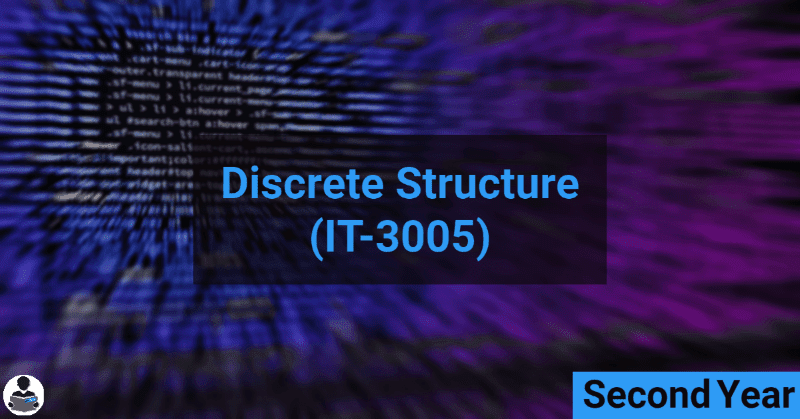Discrete Structures (IT-3005)

rgpv bhopal, diploma, rgpv syllabus, rgpv time table, how to get transcript from rgpv, rgpvonline,rgpv question paper, rgpv online question paper, rgpv admit card, rgpv papers, rgpv scheme
RGPV notes CBGS Bachelor of engineering
Course objectives
The main objectives of this course are:
1. To introduce students with sets, relations, functions, graph, and probability.
2. Students can perform set operation and solve logical reasoning and verify the correctness of
logical statement.
3. They can apply the properties of relations and find partially ordered set and lattices.
Syllabus
UNIT 1:
Set Theory, Relation, Function, Theorem Proving Techniques : Set Theory: Definition of sets,
countable and uncountable sets, Venn Diagrams, proofs of some general identities on sets
Relation: Definition, types of relation, composition of relations, Pictorial representation of
relation, Equivalence relation, Partial ordering relation, Job Scheduling problem Function:
Definition, type of functions, one to one, into and onto function, inverse function, composition of
functions, recursively defined functions, pigeonhole principle. Theorem proving Techniques:
Mathematical induction, Proof by contradiction.
UNIT 2:
Set Theory, Relation, Function, Theorem Proving Techniques : Set Theory: Definition of sets,
countable and uncountable sets, Venn Diagrams, proofs of some general identities on sets
Relation: Definition, types of relation, composition of relations, Pictorial representation of
relation, Equivalence relation, Partial ordering relation, Job Scheduling problem Function:
Definition, type of functions, one to one, into and onto function, inverse function, composition of
functions, recursively defined functions, pigeonhole principle. Theorem proving Techniques:
Mathematical induction, Proof by contradiction.
UNIT 3:
Set Theory, Relation, Function, Theorem Proving Techniques : Set Theory: Definition of sets,
countable and uncountable sets, Venn Diagrams, proofs of some general identities on sets
Relation: Definition, types of relation, composition of relations, Pictorial representation of
relation, Equivalence relation, Partial ordering relation, Job Scheduling problem Function:
Definition, type of functions, one to one, into and onto function, inverse function, composition of
functions, recursively defined functions, pigeonhole principle. Theorem proving Techniques:
Mathematical induction, Proof by contradiction.
UNIT 4:
Set Theory, Relation, Function, Theorem Proving Techniques : Set Theory: Definition of sets,
countable and uncountable sets, Venn Diagrams, proofs of some general identities on sets
Relation: Definition, types of relation, composition of relations, Pictorial representation of
relation, Equivalence relation, Partial ordering relation, Job Scheduling problem Function:
Definition, type of functions, one to one, into and onto function, inverse function, composition of
functions, recursively defined functions, pigeonhole principle. Theorem proving Techniques:
Mathematical induction, Proof by contradiction.
UNIT 5:
Posets, Hasse Diagram and Lattices: Introduction, ordered set, Hasse diagram of partially,
ordered set, isomorphic ordered set, well ordered set, properties of Lattices, bounded and
complemented lattices. Combinatorics: Introduction, Permutation and combination, Binomial
Theorem, Recurrence Relation and Generating Function: Introduction to Recurrence Relation
and Recursive algorithms , Linear recurrence relations with constant coefficients, Homogeneous
solutions, Particular solutions, Total solutions , Generating functions , Solution by method of
generating functions.
NOTES
- Unit 1
- Unit 2
- Unit 3
- Unit 4
- Unit 5
Course Outcomes
On completion of the course;
1. Students will be able to understand the notion of mathematical thinking, and algorithmic
thinking and be able to apply them in problem solving such as formal specification,
verification, and basic concepts of set theory.
2. Students understand the basic principle of Boolean algebra, logic and set theory.
3. Be able to construct simple mathematical proof and possess the ability to verify them.
Reference Books:
1. C.L.Liu” Elements of Discrere Mathematics” TMH.
2. Lipschutz, “Discrete mathematics (Schaum)”,TMH.
3. U.S Gupta “ Discrete Mathematical Structures” Pearson.
4. S. Santha,” Discrete Mathematics with Combinatorics and graph theory”, Cengage
Learning.
5. Dr.Sukhendu. Dey “ Graph Theory With Applications” Shroff Publishers
You May Also Like
- BE-3001 - Mathematics-III
- IT-3002 - Analysis and Design of Algorithms
- IT-3003 - Digital Circuit and System
- IT-3004 - Object Oriented Programming & Methodology
- IT-3006 - Computer Programming-I (Java Technology)
- IT-3007 - Rural Outreach (Internal Assessment)
- IT-3008 - NSS/NCC/Social Work (Internal Assessment)



